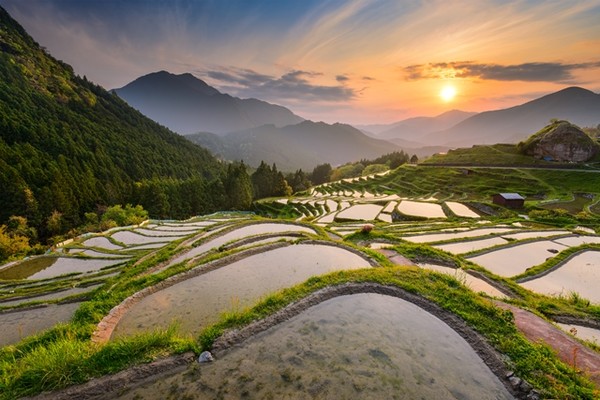
Japan, technologies for a changing agriculture
In the first 9 months of the year, sales in the Japanese agricultural machinery market declined by 8%.The aging and decreasing rural population is at the root of the stagnating demand for vehicles.The government is focusing on agriculture 4.0 to boost productivity and competitiveness in the primary sector
The first nine months of the year in the red for the tractors industry in Japan. This is what emerges from the data provided during EIMA International 2018 by Agrievolution, the association that brings together the manufacturers of the main countries producing agricultural machinery. According to the association’s statistics, sales of tractors in Japan reached 28,453 units between January and September 2018, an 8% drop compared to the same period the previous year, when sales reached 30,900 vehicles, a total for the year of 39,174 vehicles.
The slowdown of the Japanese market is part of an Asian context characterized by lights and shadows. While India’s farming equipment sector continues to mark increases (+18%), thus confirming the excellent performance of the last two years, the Chinese market instead shows a noticeable setback (-26%), also caused by the trade “wars” with the United States.
An agriculture focused on rice
The decline in sales - which has lasted for three years - is caused by the stagnation in domestic demand for agricultural machinery, which is affected by factors of a structural nature, above all due to the dynamics of an agricultural sector still strongly focused on rice cultivation.
Half of Japanese farms - reads a report from the Tokyo Ice office - continues to be specialized in the cultivation of rice, while the national rice production is less than 20% of the total agricultural production.
This means that over time the gradual diversification of the Japanese diet and the consequent decline in consumption of rice ended up negatively affecting the country’s overall agricultural production.
At present - according to a report by FederUnacoma - “Western” methods of cultivation and harvesting, i.e. on an industrial scale, are mainly concentrated in the northern island of Hokkaido, where, for meteorological and topographic reasons, there are few rice fields. Hokkaido is also the Japanese region most characterized by large-scale mechanization. However, the demographic dynamics of an increasingly aging country, where about a third of the population (27.3%) is over 65 (in the US it is 15%, in France 20%), weigh on Japanese agriculture.
This trend has also reverberated on the rural economy, which between 1985 and 2015 recorded a considerable decrease in the number of farmers (from 3.4 to 1.7 million workers), with a significant increase in their average age (66.4).
An increasingly “smart” agriculture
To compensate for the productivity and competitiveness deficit of the primary sector, the Japanese government is focusing on agriculture 4.0, which uses artificial intelligence, robotics, the “internet of things” and “big data”.
The aim of the Ministry of Agriculture, Forestry and Fisheries is that the application of smart technologies to the primary should allow not only to optimize the use of labour and to focus on quality production, but it should also encourage a greater presence of young people in the agricultural sector.
This strategy also includes the free trade agreement signed last July between the EU and Japan.
Thanks to this agreement, Tokyo will eliminate the duties on almost all imports coming from the Union and, in particular, on 80% of the fish and agricultural products. In short, for Japanese agriculture the watchwords are diversification and streamlining.
Exports prevail over imports, but Italy is the third supplier
The gap in domestic demand for technologies for agriculture is offset by Japanese manufacturers - 80% of the production is represented by Kubota, Yanmar, Iseki and Mitsubishi - with a strong export vocation, in particular to the United States (tractors) and Asia (combine harvesters). On the other hand, the spaces for imports are smaller.
“The machines imported from abroad for the three main product categories, i.e. tractors, combine harvesters and rice transplanters - reads the FederUnacoma report - only reach 3% of the total number of new machines delivered to the market every year”.
Nevertheless, the 2015-2017 three-year period saw an increase in the value of imports. In particular, the EU countries benefit from this; in 2016, they reached a share of 50% of total Japanese imports.
Where by China confirms its spot as the leading supplier of agricultural machinery for Japan (with a 20% market share in 2017), and Germany is behind it (14.2%), while Italy has a share of 13.8%, for a value of approximately 57.5 million euros. In short, Italian manufacturers pay great attention to the dynamics of the Japanese market.
This is confirmed by the first collective participation of the Italian farming equipment companies at the IAMS exhibition (International Agricultural Machinery Show) in Obihiro, a city on the northern island of Hokkaido.
Held last July, IAMS is the main trade fair of our industry in Japan. Thanks to the collaboration between FederUnacoma and ICE-Agency, it was attended by 15 companies of Italian agricultural machinery, which had the opportunity to witness first hand needs, demands and requirements of Japanese agriculture. This was an important opportunity to consolidate and improve the Made in Italy market share in the Land of the Rising Sun.








